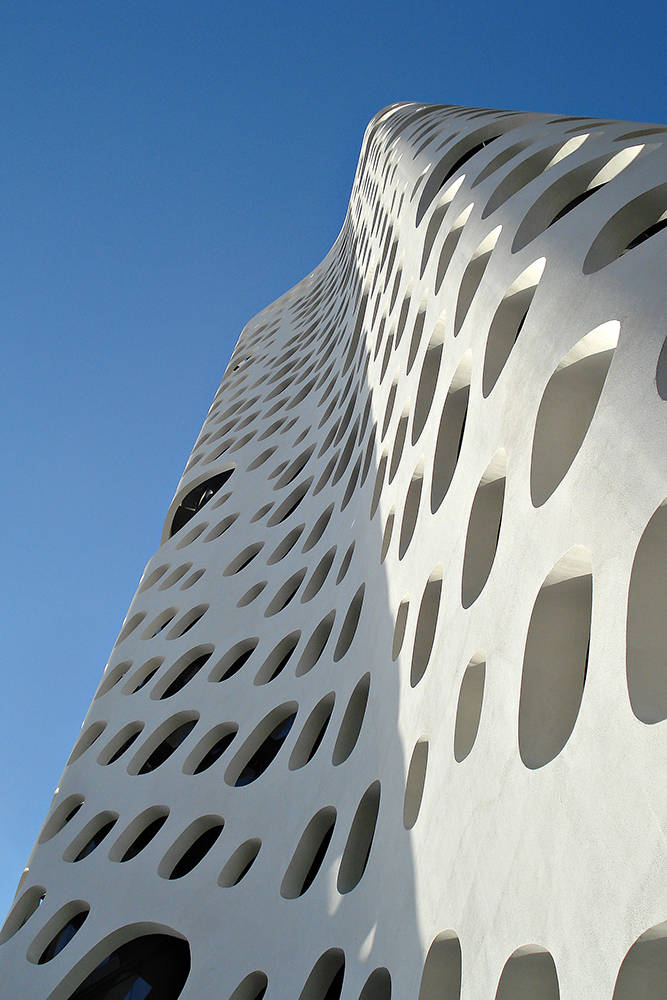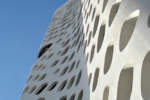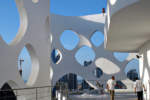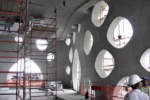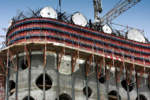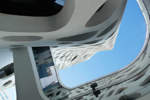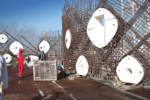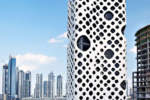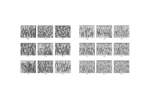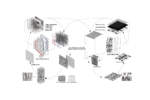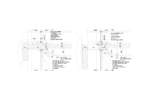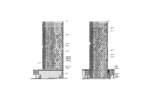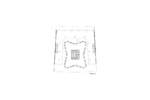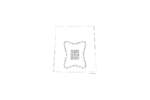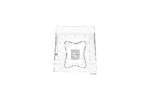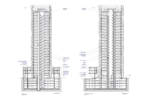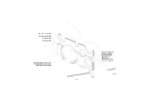architect: RUR architecture
location: Dubai, United Arab Emirates
O-14, a 22-story tall commercial tower perched on a two-story podium, broke ground in February 2007, and comprises over 300,000 square feet of office space for the Dubai Business Bay. O-14 is located along the extension of Dubai Creek, occupying a prominent location on the waterfront esplanade. With O-14, the office tower typology has been turned inside out – structure and skin have flipped to offer a new economy of tectonics and of space.
The concrete shell of O-14 provides an efficient structural exoskeleton that frees the core from the burden of lateral forces and creates highly efficient, column-free open spaces in the building’s interior. The exoskeleton of O-14 becomes the primary vertical and lateral structure for the building, allowing the column-free office slabs to span between it and the minimal core. By moving the lateral bracing for the building to the perimeter, the core, which is traditionally enlarged to receive lateral loading in most curtain wall office towers, can be minimized for only vertical loading, utilities, and transportation. Additionally, the typical curtain-wall tower configuration results in floor plates that must be thickened to carry lateral loads to the core, yet in O-14 these can be minimized to only respond to span and vibration.
Consequently, the future tenants can arrange the flexible floor space according to their individual needs.
The main shell is organized as a diagrid, the efficiency of which is wed to a system of continuous variation of openings, always maintaining a minimum structural member, adding material locally where necessary and taking away where possible. This efficiency and modulation enables the shell to create a wide range of atmospheric and visual effects in the structure without changing the basic structural form, allowing for systematic analysis and construction.
The project has generated extraordinary international interest in the architectural press as it is among the very first innovative designs to be constructed among a sea of generic office towers which have come to be the standard in Dubai’s current building boom.
In October 2008, O-14 was featured in ‘Impossible City’, an hour-long television documentary, which was produced by CBS News and aired in the U.S. on the Discovery Channel.
In May 2009, the tower’s concrete structure was completed and the building was topped out, making O-14 one of the first towers to appear in the skyline of Business Bay, Dubai, and in Spring 2011, the building was fully opened to the public. Forthcoming this fall is O-14's monograph entitled 'O-14 Projection and Reception' to be published by the Architectural Association.
The Scent of the System
Jesse Reiser and Nanako Umemoto
It is widely assumed that the architectural innovation of the 1990s was made possible by the computer, but this is only a partial truth. Certainly new technologies made possible linkages between design and the economics of production that had never before existed, yet the real breakthroughs were conceptual and aesthetic before they were technological. The politico-aesthetic ground was laid in the aftermath of exhausted strategies to produce architectural difference (deconstruction and collage) over and against Modernism’s homogeneity, through Deleuzian concepts like continuous variation and corresponding architectural models such as Jeffrey Kipnis’s theory of intensive coherence. In short, the architectural desire to produce difference through similarity pre-dated its technological employments.
Today’s current infatuation with scripting is no exception, where in the name of bespoke algorithms practitioners hope for an architecture that will be, at long last, more fully intentional, tractable and rigorous. To be sure, scripting is a useful addition to the digital toolbox when it is used to explore well-defined design concepts, but in the worst case it becomes a substitute for active judgment. Inertia takes over and architects fool themselves into thinking that repetition - simple or complex – is a form of rational thought. There are many aspects and applications of computational design and analysis that are becoming common today; the risk is that the seduction of these tools creates an illusion of rigor that obscures the role of active critical assessment. The challenge for the future development of computation in architecture is the use of discretion to know when and how it should be applied to design. In our work, computation is used as a tool to work through aesthetic and architectural agendas. One of the primary benefits of using digital tools during the design process is the increase in speed of feedback - of being able to visualize changes quickly.
The use of scripts allows us to speed up the design process to a point where we can streamline mechanical processes and complete the project with a small team. However, there is a limit to what computation as a design tool can achieve before the results become mechanical.
With this in mind, we can discuss our design for O-14, our recently completed office tower in Dubai, and its particular relationship to design, analysis and fabrication methods. The design began with a primarily aesthetic desire to see drifts of forces flowing down the building - these could have been painted or sketched - but as we attempted to develop scripts to simulate selective modulation, the desired effect was lost. We tested ways to automate the effects of the building’s gradient hole pattern but the result was not responsive enough and became too mechanical - you could smell the system through the unthinking inertia of the script. When these design ideas were turned into rules, the rules necessary to produce the local conditions became so numerous and specific that the time needed to generate each iteration was no longer efficient so eventually this approach was abandoned.
We were much more interested in the sensitive shifts and continually changing gradients that could be produced in a watercolor wash or charcoal drawing as an expression of the painter. These effects would be more localized and precise. In the end, the shell geometry, subjected to the iterative process of structural analysis and architectural modification, was created using five sizes of holes and Photoshop filters. We weren’t tied to a specific tool, and in fact much like the artist has to originate sensations in their own medium rather than representing them, the painterly effects in O-14 needed to be reoriginated as architecture; it isn’t simply a representation of a painting.
Considering the issue of how to derive design through computation, it is a question of how (and if) one can elicit new sensibilities through rule-based systems. Michelangelo’s contempt for textile weavers was widely known; he considered them to be at the bottom of the hierarchy of the arts, because he considered their work to be repetitious and unthinking. It is much easier to find rules for objective performance than for intuition or serious cultural production.
It is absolutely possible to derive mathematical formulas from a Mozart sonata but debatable whether you could run the process in the reverse and come out with a Mozart.
Workflow Case Study: O-14
O-14 is a 22-story tall commercial tower, perched on a two-story podium, that comprises over 300,000sqft of office space for the Dubai Business Bay. It is located along the extension of Dubai Creek, occupying a prominent location on the waterfront esplanade.
With O-14, the office tower typology has been turned inside out – structure and skin have conjoined to offer a new economy of tectonics and of space. The concrete shell provides an efficient exoskeleton that serves as the primary vertical and lateral structure of the building. This frees the building core from the burden of lateral forces and creates highly efficient and flexible column-free open spaces in the building’s interior.
The shell is organized as a diagrid, the efficiency of which is wed to a system of variable-sized openings that always maintain a minimum structural requirement by adding material locally where necessary and taking away where possible. The efficiency and flexibility of this system enabled us to create a wide range of atmospheric and visual effects without changing the basic structural logic, allowing for systematic analysis and efficient construction methods. A common misreading of O-14 is that the diagrid pattern is a direct materialization of the structural forces on the shell. This approach would have yielded a much more aesthetically homogeneous result. Certainly, the structural logic of the gravity-loaded exoskeleton had to be taken into account, but the redundancy inherent to the diagrid gave us a tremendous amount of expressive freedom.
Aesthetic Expression vs. Structural Rationalization
Modeling and analyzing the shell of O-14 was a key part of the design. In our initial meeting with the structural engineer, Ysrael A. Seinuk, we showed two different options for the openings: orthogonal and diagonal. Their recommendation was to avoid the orthogonal, as its structural consequence would result in many small Vierendeel frames, while the diagonal option offered the benefit of channeling both gravity and lateral loads to the base of the building. This was consistent with our aesthetic interests and gave us more opportunity to pursue the aesthetic objectives of the design. The collaborative process began with Reiser + Umemoto generating a 3D model of the shell, indicating preliminary locations of the openings. This first iteration of the shell geometry was subject to a structural analysis program but deliberately run ”weak”, i. e. tested in a low-strength concrete so as to exaggerate the formation of the stress patterns. This index of invisible forces was selectively enhanced or diminished in the geometry of the next iteration, so as to propagate the desired density pattern of solids and voids in the overall shell. The size and location of these openings were adjusted accordingly, resulting in a modulated grid pattern.
Comments on the model were then sent back to the architect to determine the architectural implications of these changes, after which the architect revised the model to send back to the engineer for more analysis. This process took several iterations, until the final design of the shell’s apertures, elements and grid pattern fulfilled both the architectural and structural requirements.
When considering the expression of O-14, one must keep in mind the development of structural technologies from the load-bearing logics of masonry to the vector-based logics of steel. The shift from arch-and-wall to column-and-beam techniques signified a shift in thinking about matter, in which the structural logics within building components became freed from the ”excessive” material surrounding them – the ability to more accurately calculate structural forces resulted in an economy of material. The logical extension of this shift led to the pursuit of an ideal structural form – the development of the I beam, truss, space frame, cable and anchor point system, etc. – which was the precursor to the machine-aesthetic and the modern concept of functionalism – including its eventual degradation into the baleful High Tech and currently to the highly optimized yet culturally reductive phase of performance architecture.
In this spirit, high Modernism has been shaped by the dialectic between the generic and the accidental: wherein the generic is classical and impersonal and the accidental is singular and unique.
Our design method attempts to circumvent this dialectic by assuming that the repetition of the Modernist diagrid can be modulated in such a way as to produce singular architectural features, thus overcoming its homogeneity while retaining its systemic coherence.
The diagrid of O-14 is neither arbitrary nor structurally ideal – each perforation reads independently and as part of a combinatory pattern. This approach assumes an active management of the relationship between the building geometry and its material behavior; however, it avoids the twin traps of either the simple optimizing ethos of structural rationalism, or its hypertrophied version: structural expressionism. The design of O-14 compounds these ideas beyond just the appearance, porosity and affects generated by the façade, extending to the uses and functions of the office spaces within, where the program is intended to locally reorganize itself in relationship to the ever-changing gradient of apertures.
In opposition to what one might consider the inherent expressive qualities of the tower topology, the façade pattern of O-14 is not tied to an overall regulating geometry and attempts to defy a rational reading of force transfer. The pattern seeks to attenuate the monotony associated with office towers, while still preserving the sense of the sublime and the monumental.
The deliberate lack of alignment between the perforations and the floor plates obscures legibility and challenges an easy reading of the building’s height and scale. There is a graphic desire driving the design process, a desire that overrides the structural and environmental logics. The modulation of pattern works like camouflage, becoming disruptive and de-materializing the tower block. The shell's pattern changes as its relationship to the viewer changes, and when combined with additional patterns of light and shadow, produces a sort of virtual form.
Because of the effects of this virtual form, the actual form of the building can be simplified and respond to the logics of production methods, structural analysis and economy.
There was a constant negotiation between four different tracks of design criteria: material, aesthetic, linguistic and performative. These were not equal in their influence. The graphic articulation of the façade took precedence over the others, resulting in “over-structuring” the shell, to the point where optimization was no longer important. The shell became a fictional index of forces in the end – something akin to the anatomical license in 19th-century neoclassical painting - where upon close inspection, the pattern is slightly off creating a vivid and visceral impression of the force flows in the shell. The pattern cannot be fully understood through a single lens and is a form of very precise fiction. If we had considered the index of forces only from a structurally optimized perspective, they would not have been particularly expressive of anything other than structure.
Sustainability / Environmental Effects
Likewise, the sustainable aspects of the design were derived from a desire for aesthetics as well as performance. In addition to serving as its main architectural feature and the primary structural system, the perforated concrete tubular shell is also an environmentally smart brise-soleil open to light, air and views. Our first design iterations had the floor slab edges directly in contact with the shell, but this, like the initial orientation of the openings, over-emphasized their horizontality as they were directly registered on the façade. To reinforce the aesthetic desire for scalar ambiguity, the slabs were separated from the shell except at selective connection points, which made them recede in space. Since the locations of the openings vary throughout the façade, the connections between the floor slab and the shell are different at every floor. This created a space between the glass window wall and the shell, which was later increased to one meter for more pragmatic reasons, to fit a window-washing track onto each slab edge. The gap between the main enclosure and exterior shell had the additional benefit of creating a chimney effect, which effectively cools the surface of the glass windows behind the perforated shell. This passive solar technique became an integral part of the cooling system, reducing energy consumption and costs by more than 30%. Once we became aware of the dynamic of the gap, we refined it by minimizing the width of the structural connections (the tongues) between shell and slab. The evolutionary biologist Stephen Jay Gould calls this a process of exaptation, where novel performance arises from the (geometrical) byproducts of other primary operations.
Construction Methodology
In order to construct the perforated exoskeleton, a slip-form construction technique was utilized where modular concrete forms moved up along the building axis, preventing costly dismantling and setup of formwork with complex shapes. Self-consolidating concrete was used to flow between the intricate matrix of reinforcing bars and polystyrene void forms used to shape the openings. Our original thought was that by limiting the openings to five sizes, we could work with a limited number of reusable forms made of a flexible material, such as rubber, which would be able to repeatedly bend to conform to the tower’s plan geometry.
This idea proved incorrect, however, as the cost of the actual reusable molds, as well as the effort required to recycle them, would have been greater than the cost of milling each mold individually out of a disposable material like polystyrene. The geometry of the molds were complicated by the curving surface of the shell, so we offered to provide separate digital files to the fabricator to mill each mold. However, the fabricator chose to redraw each one individually by hand, using the standard arc notations for the inside and outside surface of the shell and then projecting between them to generate the thickness. Thus after all the planning and precision, the success of the project was due more to the superb craftsmanship of the contractor than the ability to digitally control all aspects of the process, from design through construction.


